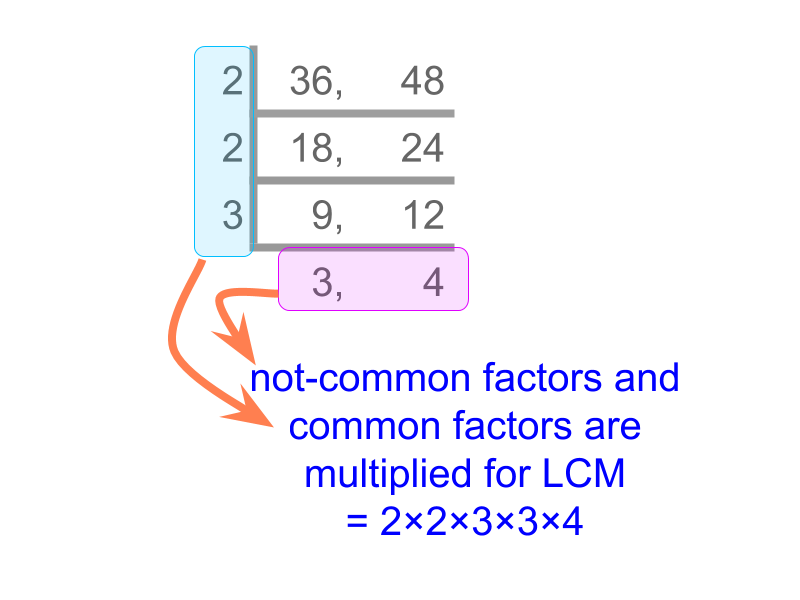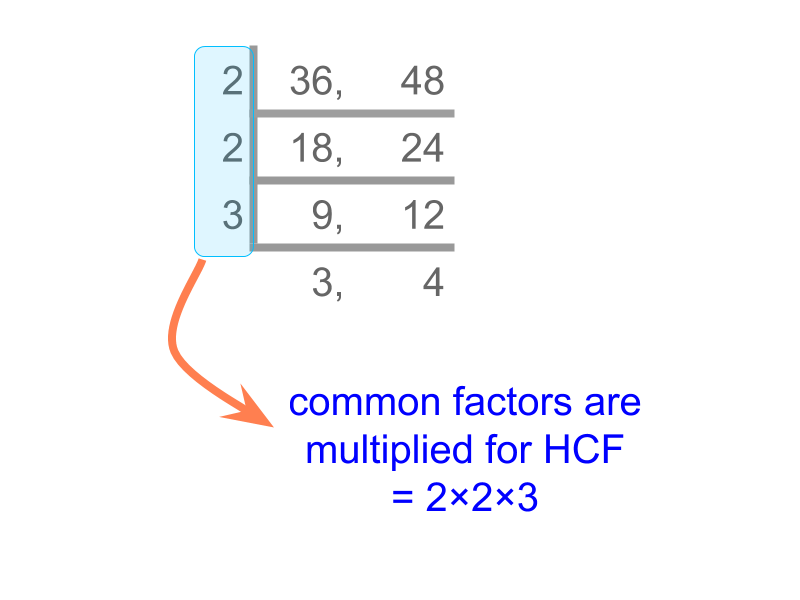
what you'll learn...
overview
This page provides a brief overview of
common multiples of two or more numbers,
lowest common multiple of two or more numbers,
least common multiple using factorization method,
product of numbers equals product of their LCM and HCF
Common Multiples
The multiples of 66 are 12,18,24,30,36,42,48,...12,18,24,30,36,42,48,... and the multiples of 88 are 16,24,32,40,48,...16,24,32,40,48,....
What are the common multiples in these two are "24,48,72,...24,48,72,..."
Common Multiples : Multiples common between two or more numbers are common multiples of those numbers.
The common multiples of 22 and 4 are "4,8,12,⋯".
The common multiples of 8 and 3 are "24,48,⋯"
Least Common Multiple
The multiples of 6 are 12,18,24,30,36,42,48,... and the multiples of 8 are 16,24,32,40,48,....
The common multiples are 24,48,72,...
The least value in the common multiples is "24"
Least Common Multiple : The lowest multiple in the common multiples of two or more numbers is the least common multiple (LCM) of those numbers.
Find the LCM of 2 and 4 is "4".
The multiples of 2 are 2,4,6,8,⋯.
The multiples of 4 are 4,8,12,⋯.
The common multiples are 4,8,12,⋯.
The least of the common multiples is 4.
The LCM of 15 and 10 is "30".
The multiples of 15 are 15,30,45,60,⋯.
The multiples of 10 are 10,20,30,⋯.
The common multiples are 30,60,⋯.
The least of the common multiples is 30.
LCM Factorization Method
Consider finding the LCM of 36 and 48. It is not simple to list the multiples of the large
"Prime factorization of numbers" helps to simplify the problem of finding LCM of large numbers.
Consider finding the LCM of 36 and 48.
A simplified procedure is given in the figure. The numbers are divided successively by common factors. The common factors and non-common factors are multiplied to get LCM.

Factorization Method to find LCM : The numbers are successively divided by common factors. Product of common factors and the non-common factors is the LCM.
Find the LCM of 280 and 420.
 The Factorization Method is used to find the LCM. The answer is "840".
The Factorization Method is used to find the LCM. The answer is "840".
Relation between two numbers, their LCM and HCF
The HCF of 36 and 48 is "12".

The LCM of 36 and 48is "144".


Consider the example : finding HCF of two numbers. From this, it is understood that HCF is "product of common prime-factors".

Consider the example : finding LCM of two numbers. From this, it is understood that LCM is "product of common and non-common prime-factors".
Consider two numbers with HCF n. The numbers can be given in the form n×p and n×q.
For example, HCF 36 and 48 is 12.
And 36=12×3 and 48=12×4.
In this example n=12, p=3 and q=4.
The p and q are derived from the non-common prime factors of the two numbers.
What is the LCM of the two numbers n×p and n×q?
The answer is "n×p×q"
Given two numbers n×p and n×q where n is the HCF
and n×p×q is the LCM.
Is there a relation between the two numbers, the HCF and the LCM?
The answer is "both the following".
product of the numbers equal product of LCM and HCF and
(n×p)×(n×q)= HCF × LCM
LCM HCF Product Property : Product of LCM and HCF equals product of the numbers.
Given LCM 440 and HCF 22. One number is 88 what is the other number?
The answer is "110".
As per the LCM HCF Product Property
440×22=88× number
number = 440×22÷88
=110
summary
Common Multiples : Multiples common between two or more numbers are common multiples of those numbers.
Least Common Multiple : The lowest multiple in the common multiples of two or more numbers is the least common multiple (LCM) of those numbers.
Factorization Method to find LCM : The numbers are successively divided by common factors. Product of common factors and the non-common factors is the LCM.

LCM HCF Product Property : Product of LCM and HCF equals product of the numbers.
Outline
The outline of material to learn "Divisibility in Whole Numbers" is as follows.
Note: click here for detailed outline of Whole divisors
→ Classification as odd, even, prime, and composite
→ Factors, Multiples, Prime factorization
→ Highest Common Factor
→ Lowest Common Multiple
→ Introduction to divisibility tests
→ Simple Divisibility Tests
→ Simplification of Divisibility Tests
→ Simplification in Digits for Divisibility Tests